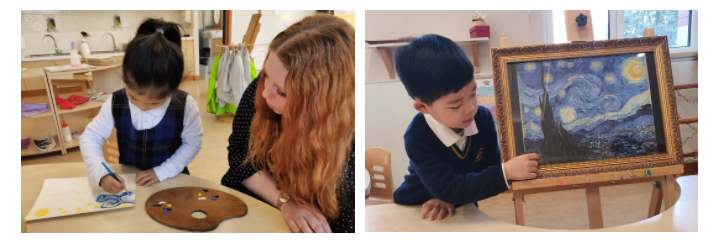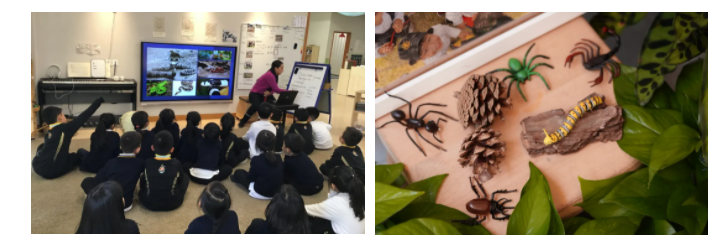

‘It is too cold to play outside,’ is a phrase that one often hears from many adults as the weather gets colder. Yet winter weather provides us with many exciting learning opportunities and benefits for our learners. What are the benefits of outdoor learning during the colder months of the year and are there any downsides?

01: Winter play improves physical development
One of the main aspects of the curriculum at this age is allowing children to become more aware of their bodies, of its needs, its experiences and how to take care of it. Experiencing the cold weather allows children to understand the importance of dressing appropriately. It develops fine motor skills as children work on the zips, buttons and straps that are part of getting dressed for cold weather. If the ground is wet and slippy, children must focus on their balance and core muscles – something that has a direct impact on both their physical and cognitive development.
Recently EY3 had fun experimenting with a layer of ice that had formed over our mud kitchen. Working closely with their teachers the children experienced what it was like to stand on ice and to see the difference it made by spreading their weight out or concentrating it on a single spot.
02: Winter play creates new learning opportunities
With the change in seasons the world around us provides us with a wide range of exciting learning opportunities. Children can look at how and why the world around them is changing. Falling leaves, frost, and winter plants create inspiration for amazing pieces of artwork. Describing what we can see and the new sensations we are feeling helps develop our communication and language skills and build up both our English and Chinese vocabulary.
EY2 have been making the most of the cold weather by playing with ice. As well as learning about freezing and melting, they were able to develop their creative skills by building ice lanterns. As the weather has started to get warmer, some children are asking to use the freezer so that this art form can continue.
03: Winter play is good for our health
Contrary to popular belief, playing outside during the winter can be good for us. Being outside during the winter prevents the spread of many diseases and helps with the creation of vitamin D as well as the many benefits of regular outdoor play such as improved wellbeing, concentration and involvement.
EY4 showed wonderful levels of wellbeing and involvement recently as they discovered large amounts of ice in our outdoor water area. They fished for ice, made ice-creams and completely immersed themselves in their own world of make believe and ice magic.
At Huili Nursery we value and make the most out of the learning opportunities each season provides. We hope that you can join us in celebrating our children’s successes. We hope too that we have inspired you to step outside and enjoy the cold before the inevitable progress towards spring and the new learning that exciting season will bring.


Our exploration was inspired by a little girl in EY1 who would like to make clothes for her teddy bear. Her ideas were shared with the other children during one of our bilingual sessions. After one older sister from EY4 was invited to share her experience in making clothes, more and more children showed their interest in the provocation related to sewing. As a learning community it was decided, following the children's emergent learning and lead them into the world of sewing. Children practiced threading a needle, which provided a good opportunity for them to develop their fine motor skills and hand-eye coordination. Children had chosen their favourite piece of cloth. In the process of creation, they had the experience of painting on cloth. Each piece of unique fabric had a special place in the children's heart. We also moved our learning to the nursery communal areas to observe the sewing machine and see how the big machine could sew different pieces of fabric together. A special thank you to Ms. Qiao, our nursery cleaner and Ms. Huang, EYA from EY2 who showed us how to use the sewing machine. Next, we will have a parent expert for our children. She will share her experience in sewing clothes for bears with our children. Our exploration continues…


Children in EY2Unit were creating a forest in the small room next to our classroom with their artistic and creative imaginations. Some children chose green paper as their background because “there are many areas of green grass and trees in the forest”. Some children described a lovely snail and said: “Its home is in the forest.” More children started to immerse themselves in the scene and imagined themselves as one of the animals in the forest. Playing with the light offered them many different experiences. Children started to think whether animals go to sleep at home like us when it is dark. What are the differences between forest nights and city nights?


This week the children have observed and been inspired by the work of Vincent Van Gogh. The children have experimented with different painting techniques through sensory painting, using cotton wool buds, spatulas, sponges, brushes and their fingers to create art that reflects their thoughts on Vincent Van Gogh’s the Starry Night on the Rhone and to explore the spiraling shapes and texture found in his work.


Since coming back from our winter break, EY4Unit have been investigating the topic of 'Animals'. They created a bank of questions that they would like to investigate, whilst using their curiosity, creativity and inspiration. This week they focused on looking at grouping animals based on what they eat. They observed animals that are carnivores and herbivores, which has answered a few of their original questions. They have been using various areas in the classroom to express their thoughts and ideas, including the blocks area, the clay table and also by using spare materials, so they can express the fruits of their imagination in many ways.
